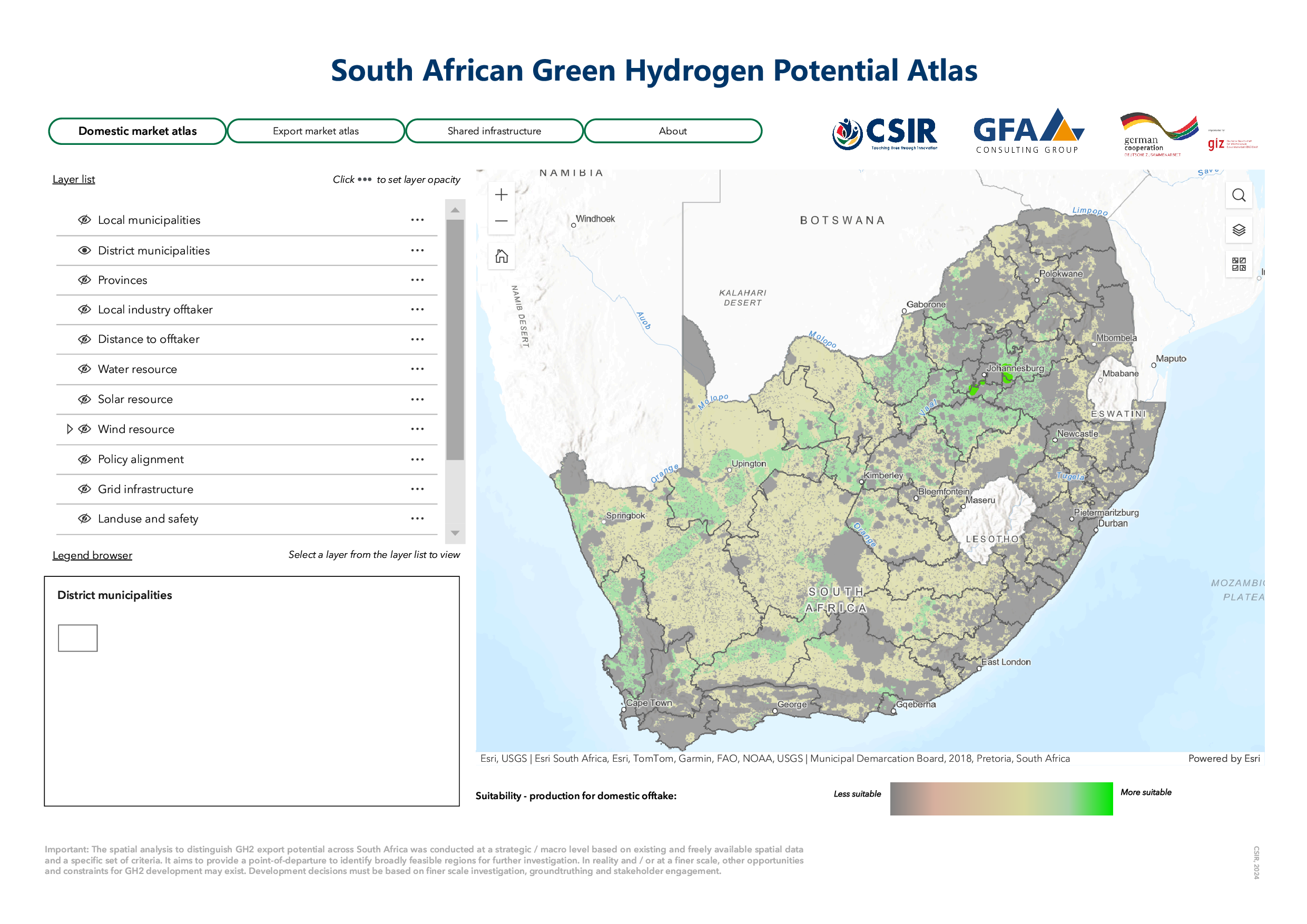South African Green Hydrogen EIA Guideline and Potential Atlas launched
Titled “Managing the impacts of a Green Hydrogen / Power-to-X economy: an Environmental Impact Assessment Guideline for South Africa”, the instructional manual offers practical guidance for assessment practitioners, project developers, decision-makers and stakeholders involved in the planning and environmental authorisation processes for complex green hydrogen systems.
Two environmental planning tools were released by the Department of Forestry, Fisheries and the Environment, the Deutsche Gesellschaft für Internationale Zusammenarbeit (GIZ), the Council for Scientific and Industrial Research (CSIR) and GFA Consulting Group in Pretoria today – an Environmental Impact Assessment Guideline (EIA) for green hydrogen projects and the South African Green Hydrogen Potential Atlas, an online geospatial atlas depicting the potential and suitability for green hydrogen development. CSIR experts in environmental impact assessment played a key role in generating these tools that contribute to the responsible planning and development of green hydrogen technologies in South Africa.
Development of the tools were funded by the H2.SA Programme, an initiative by the GIZ to promote a South African green hydrogen economy. Green hydrogen (i.e. hydrogen produced with renewable energy) has the potential to replace fossil fuels in ‘hard-to-abate’ industries like cement and steel; and in mobility applications such as aviation, road and rail bulk transport and marine shipping.
Titled “Managing the impacts of a Green Hydrogen / Power-to-X economy: an Environmental Impact Assessment Guideline for South Africa”, the instructional manual offers practical guidance for assessment practitioners, project developers, decision-makers and stakeholders involved in the planning and environmental authorisation processes for complex green hydrogen systems. The guideline provides an overview of what green hydrogen development entails, the associated policy and regulatory context, guidance on best practice EIA and useful tools for planning projects and assessing impacts.
The South African Green Hydrogen Potential Atlas is one such tool that aims to support the spatial planning of green hydrogen developments. It is the product of a multi-criteria analysis which considered spatially explicit key siting variables that represent environmental conditions and sensitivities, different uses and users of the environment, and the requirements for green hydrogen production. The atlas showcases the potential for green hydrogen production aimed at export and domestic markets and additionally shows where enabling shared infrastructure could be leveraged to create a South Africa green hydrogen economy.
“Green hydrogen projects are novel and very complex. These tools are intended to assist industry, government, NGOs and other stakeholders in integrating the environmental and social planning of green hydrogen projects into existing legislation and decision making,” says Paul Lochner, the leader of the CSIR’s Environmental Management Services group.
“As a freely available resource, the atlas can assist in identifying spatial prospects and constraints for green hydrogen development,” says CSIR senior researcher Luanita Snyman-van der Walt.
”The atlas provides significant value by offering an integrated environmental and techno-economic view of potential green hydrogen development opportunities. It aims to provide a point-of-departure to identify regions which could be further investigated for green hydrogen development feasibility. It is based on the best available data at the time, but to err on the side of caution, development decisions must be based on fine scale investigation, ground truthing, and stakeholder engagement.”
It took the researchers from CSIR and GFA Consulting Group 24 months to develop the EIA guideline and the atlas, which are two outputs from an extensive body of work which also produced, inter alia, pre-feasibility guidance for green ammonia and methanol projects, a Life Cycle Assessment for green ammonia, and a comprehensive green hydrogen project developer’s guide. The atlas can be accessed online at https://bit.ly/SAGH2atlas whilst the EIA Guideline is available at https://bit.ly/SAGH2eia.
South Africa’s abundant wind and solar energy resources, expansive land, port infrastructure, central geographical location on shipping lanes between markets in Europe and the east, and platinum group metal reserves could give it a competitive advantage in producing green hydrogen and other Power-to-X derivatives, contributing to decarbonising local and global economies.
-ENDS-
Issued by CSIR Strategic Communication
For more information, contact:
Phetolo Phatsibi: CSIR Media Relations Practitioner
Email: PPhatsibi@csir.co.za
Mobile: 081 396 8871
About the CSIR:
The CSIR, an entity of the Ministry of Science, Technology, and Innovation, is one of Africa’s leading organisations in scientific and technology research, development and implementation. Constituted by an Act of Parliament in 1945 as a science council, the CSIR undertakes directed and multidisciplinary research and technological innovation, as well as industrial and scientific development, to improve the quality of life of all South Africans.
This year, the CSIR celebrates 80 years of touching lives through innovation. For more information, visit www.csir.co.za
Follow us on social media:
X (Twitter): @CSIR. Facebook: CSIRSouthAfrica. Instagram: CSIRSouthAfrica. LinkedIn: Council for Scientific and Industrial Research (CSIR). YouTube: CSIRNewMedia

